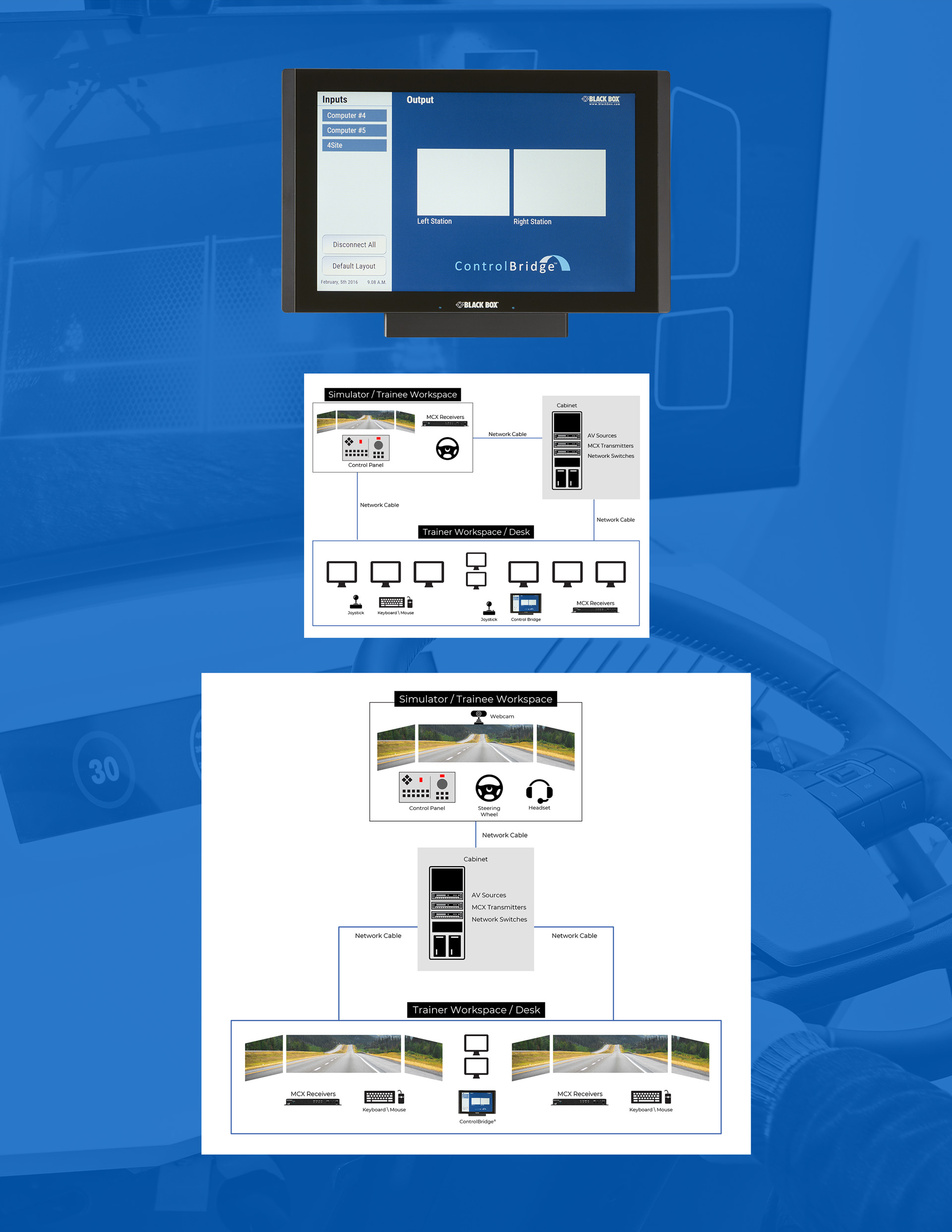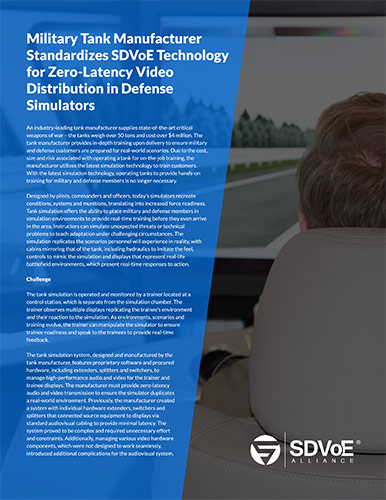Military Tank Manufacturer Standardizes SDVoE Technology for Zero-Latency Video Distribution in Defense Simulators

An industry-leading tank manufacturer supplies state-of-the-art critical weapons of war – the tanks weigh over 50 tons and cost over $4 million. The tank manufacturer provides in-depth training upon delivery to ensure military and defense customers are prepared for real-world scenarios. Due to the cost, size and risk associated with operating a tank for on-the-job training, the manufacturer utilizes the latest simulation technology to train customers. With the latest simulation technology, operating tanks to provide hands-on training for military and defense members is no longer necessary.
Designed by pilots, commanders and officers, today’s simulators recreate conditions, systems and munitions, translating into increased force readiness. Tank simulation offers the ability to place military and defense members in simulation environments to provide real-time training before they even arrive in the area. Instructors can simulate unexpected threats or technical problems to teach adaptation under challenging circumstances. The simulation replicates the scenarios personnel will experience in reality, with cabins mirroring that of the tank, including hydraulics to imitate the feel, controls to mimic the simulation and displays that represent real-life battlefield environments, which present real-time responses to action.
Challenge
The tank simulation is operated and monitored by a trainer located at a control station, which is separate from the simulation chamber. The trainer observes multiple displays replicating the trainee’s environment and their reaction to the simulation. As environments, scenarios and training evolve, the trainer can manipulate the simulator to ensure trainee readiness and speak to the trainees to provide real-time feedback.
The tank simulation system, designed and manufactured by the tank manufacturer, features proprietary software and procured hardware, including extenders, splitters and switchers, to manage high-performance audio and video for the trainer and trainee displays. The manufacturer must provide zero-latency audio and video transmission to ensure the simulator duplicates a real-world environment. Previously, the manufacturer created a system with individual hardware extenders, switchers and splitters that connected source equipment to displays via standard audiovisual cabling to provide minimal latency. The system proved to be complex and required unnecessary effort and constraints. Additionally, managing various video hardware components, which were not designed to work seamlessly, introduced additional complications for the audiovisual system.
The tank manufacturer required an all-in-one solution for distributing audio and video throughout the simulation chamber and control station. The system needed to eliminate the constraints of their current system of individual hardware components while delivering high-definition and zero-latency video and audio to provide the required real-world environment, as a mere millisecond delay in response could lead to an unfavorable outcome on the battlefield.

Solution
Black Box provided a solution to replace the current audiovisual system while meeting the requirements of the tank manufacturer. Black Box’s MCX AV-over-IP, powered by SDVoE technology, provided real-time (less than 0.03 milliseconds) glass-to-glass encoding and decoding capabilities. Additionally, the MCX 4K provided an easy-to-deploy solution, which reduced the existing cabling restraints and distance limitations of the prior cabling solution. The MCX 4K required significantly less equipment and, as a result, created a cost-effective, energy-efficient solution.
The simulator manufacturer connected the video source devices to Black Box’s MCX encoders and the multiple displays to MCX decoders. The endpoints, networked together through a network switch, provided seamless, zero-latency connectivity for the entire system. Additionally, the MCX controller was connected to the network to completely control the entire audio and video system, allowing them to distribute the video sources to any required displays and present content in multiview format across multiple displays.
 SDVoE technology, as implemented through Black Box’s MCX, provided all-in-one unification by combining the extension, switching and splitting functionality to create a single system of products. An easy-to-install system, Black Box’s MCX allowed for all components to be connected to a PoE network switch, providing connectivity to the system while powering the endpoints and eliminating bulky external power supplies.
SDVoE technology, as implemented through Black Box’s MCX, provided all-in-one unification by combining the extension, switching and splitting functionality to create a single system of products. An easy-to-install system, Black Box’s MCX allowed for all components to be connected to a PoE network switch, providing connectivity to the system while powering the endpoints and eliminating bulky external power supplies.
Benefits of SDVoE Technology
SDVoE reaches beyond existing standards to provide benefits no other technology can claim:
- A complete ecosystem – SDVoE Alliance members are manufacturers with expertise in signal distribution, display manufacture, IT infrastructure, chip design and AV software. The integrator has dozens of partners to align with and products to choose from.
- A flexible yet simple software platform – the SDVoE API allows rapid development of highly specialized software, custom-tailored to the needs of a vast array of end users.
- A full OSI stack solution – only SDVoE offers the simplicity of a complete top to bottom solution, fully encompassing infrastructure, transport, processing, and a simple control layer.
For more information on the SDVoE Alliance, please visit www.sdvoe.org. Keep up with the latest news from the SDVoE Alliance on LinkedIn, Twitter and YouTube.
SDVoE Alliance® is a registered trademark and SDVoE™ and SDVoE API™ are trademarks of the SDVoE Alliance. All other trademarks are the property of their respective owners.
Topics
To download the case
study as a PDF, click here.
Stay
informed
Keep up to date on SDVoE Alliance news and events. Subscribe to our newsletter.


